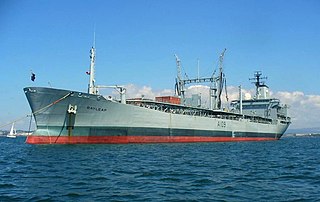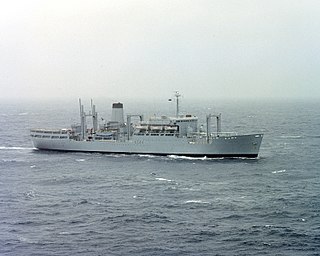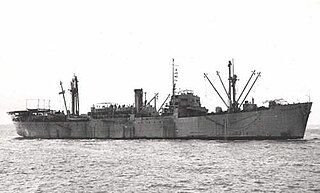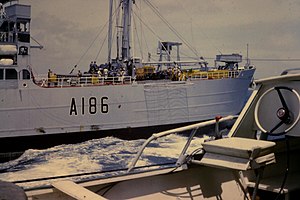
The Royal Fleet Auxiliary (RFA) is a naval auxiliary fleet owned by the UK's Ministry of Defence. It is a component of His Majesty's Naval Service and provides logistical and operational support to the Royal Navy and Royal Marines. The RFA ensures the Royal Navy is supplied and supported by providing fuel and stores through replenishment at sea, transporting Royal Marines and British Army personnel, providing medical care and transporting equipment and essentials around the world. In addition the RFA acts independently providing humanitarian aid, counter piracy and counter narcotic patrols together with assisting the Royal Navy in preventing conflict and securing international trade. They are a uniformed civilian branch of the Royal Navy staffed by British merchant sailors. The RFA is one of five RN fighting arms.

RFA Orangeleaf was a Leaf-class fleet support tanker of the Royal Fleet Auxiliary (RFA), the naval auxiliary fleet of the United Kingdom, and which served with the fleet for over 30 years, tasked with providing fuel, food, fresh water, ammunition and other supplies to Royal Navy and allied naval vessels around the world.

RFA Fort Austin is a retired British Fort Rosalie-class dry stores ship of the Royal Fleet Auxiliary.

RFA Gold Rover was a Rover-class small fleet tanker of the Royal Fleet Auxiliary (RFA) and one of five ships that were designed by the Admiralty, all of which were built at the Swan Hunter shipyard.

RFA Bayleaf (A109) was a Leaf-class support tanker of the Royal Fleet Auxiliary (RFA), the naval auxiliary fleet of the United Kingdom, which served with the fleet for 30 years, tasked with providing fuel, food, fresh water, ammunition and other supplies to Royal Navy vessels around the world.

RFA Fort Rosalie was the lead ship of her class of Royal Fleet Auxiliary fleet replenishment ships. Fort Rosalie was originally named RFA Fort Grange, but was renamed in May 2000 to avoid confusion with the now-decommissioned RFA Fort George. On 31 March 2021, the ship was withdrawn from service.

RFA Fort Victoria is a Fort-class combined fleet stores ship and tanker of the Royal Fleet Auxiliary of the United Kingdom tasked with providing ammunition, fuel, food and other supplies to Royal Navy vessels around the world. She is now the only member of her class.

RFA Olwen (A122) was an Ol-class "fast fleet tanker" of the Royal Fleet Auxiliary (RFA), the naval auxiliary fleet of the United Kingdom. She was the lead ship of her class, and launched in 1964 as RFA Olynthus, the second ship to bear this name.

RFA Stromness (A344) was a fleet stores ship which served the Royal Fleet Auxiliary until sold to the U.S. Navy's Military Sealift Command in 1983. While in the service of British forces, it saw service in the Falklands War. After the sale to the United States, it was renamed USNS Saturn (T-AFS-10) and acted as a combat stores ship until it was deactivated in 2009; it was able to supply two other ships at once. In 2010, it was sunk in an exercise by the U.S. Carrier Strike Group Two off the coast of North Carolina.

RFA Fort Charlotte (A236) was a stores issuing ship of the Royal Fleet Auxiliary.

RFA Fort Duquesne (A229) was an air stores ship of the Royal Fleet Auxiliary a Fort type ship.
RFA Fort Langley (A230) was a stores ship of the Royal Fleet Auxiliary.

RFA Fort Sandusky (A316) was an armament stores carrier of the Royal Fleet Auxiliary (RFA).

RFA Resource was an armament stores ship of the Royal Fleet Auxiliary (RFA), the naval auxiliary fleet of the United Kingdom.

SS Fort Cataraqui was a North Sands-type Fort ship. The North Sands type, along with similar Park, Fort, and Canadian Liberty classes were essentially British and Canadian variants of the American Liberty and Victory classes. Fort Cataraqui is notable for being the first Allied ship to enter the port of Antwerp after the Canadian First Army cleared the Scheldt Estuary during the Battle of the Scheldt in the Second World War.

The Fort Rosalie or Fort class of fleet replenishment vessel of the British Royal Fleet Auxiliary were designed to replenish Royal Navy taskgroups with various armaments and victualling stores while under way. Unlike the bigger Fort Victoria class, they supply dry stores and not fuel. RFA Fort Rosalie was originally known as Fort Grange but was renamed in 2000 to avoid confusion with the new Fort Victoria-class replenishment oiler RFA Fort George. Both ships were withdrawn from service and later sold in 2021.

RFA Wave Ruler is a Wave-class fast fleet tanker of the Royal Fleet Auxiliary (RFA) of the United Kingdom tasked with providing fuel, food, fresh water, ammunition and other supplies to Royal Navy vessels around the world.

The Ol-class tankers were a series of three "fast fleet tankers" used by the Royal Fleet Auxiliary (RFA), the naval auxiliary fleet of the United Kingdom, tasked with providing fuel, food, fresh water, ammunition and other supplies to Royal Navy vessels around the world.

The Fort ships were a class of 198 cargo ships built in Canada during World War II for use by the United Kingdom. They all had names prefixed with "Fort" when built. The ships were in service between 1942 and 1985, with two still listed on shipping registers until 1992. A total of 53 were lost during the war due to accidents or enemy action. One of these, Fort Stikine, was destroyed in 1944 by the detonation of 1,400 tons of explosive on board her. This event, known as the Bombay Explosion, killed over 800 people and sank thirteen ships. Fort ships were ships transferred to the British Government and the Park ships were those employed by the Canadian Government, both had the similar design.
RFA Darkdale was a Dale-class fleet tanker of the Royal Fleet Auxiliary (RFA), launched on 23 July 1940 as Empire Oil, completed in November 1940 and transferred to the RFA as Darkdale. She was sunk during the Second World War on 22 October 1941 by the German submarine U-68. Her wreck in James Bay off Jamestown, Saint Helena continued to leak oil, posing a potential environmental threat to the coastal waters of Saint Helena, until Ministry of Defence divers drained the ship's tanks in 2015.


















